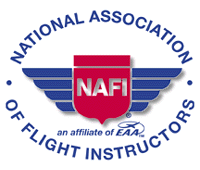Instruction
Topics on this page: A great aviation primer, “Hi! Lets go fly!”, The “Right Stuff”—How to get it, Knowing vs. applying, and What is in an Instrument Rating course?.
A great aviation primer
Stick and Rudder has been an aviation classic for generations of pilots. This book covers basic flying in a more straightforward manner than any other before or since.
If you’re a pilot, you probably have this book already. If you’re considering learning to fly, start with this book.
 |
By Wolfgang Langewiesche
McGraw-Hill Professional; 1944
Hardcover; 390 pages
ISBN 0-07-036240-8

|
“Hi! Lets go fly!”
Uh oh! This is not the way most flight lessons should start. (Although it may be fun once in a while.) Before you jump in the airplane, you and your instructor should sit down and:
- Agree on the objective of the lesson.
- Discuss the reading you did beforehand (you did finish your homework, right? :-) ) and answer all of your questions.
- Walk-through the maneuvers or tasks you’ll be flying today.
- Try some examples on paper (or the whiteboard), to practice the concepts.
One you’re feeling good about your knowledge of the lesson, only then is it time to go fly and work on the skills of the lesson.
I’ve met students whose instructors “didn’t do ground”. Unfortunately, these students were figuratively and literally being “taken for a ride” by these lousy instructors. After many wasted hours (and dollars), they were not making progress. When they experienced a properly taught program, the rate at which they learned and developed their skill jumped. A frustrating experience became enjoyable.
So, if your instructor always greets you with “lets go fly!”, consider responding with “bye-bye”.
The “Right Stuff”—How to get it
Your first book in your aviation library should be an aviation primer—“how to fly”. Your second book should be “how to learn”. In Redefining Airmanship, Lt. Col. Tony Kern, USAF, teaches you what really makes up the “right stuff”. General Chuck Yeager, USAF, says simply “Kern hits the mark”.
Kern discusses discipline, skill, proficiency, situational awareness, and judgement, and how you obtain and improve them. He breaks airmanship knowledge into five pillars: self, aircraft, team, environment, and risk, and spends a chapter on each.
Well written, with many fascinating examples of good and poor airmanship. This book belongs on every pilot’s bookshelf, from Cessna 150 flyers to 747 captains.
 |
By Tony Kern
McGraw-Hill Professional; 1997
Hardcover; 463 pages
ISBN 0-07-034284-9
 |
Knowing vs. Applying
There are many instructors out there. Many can spout back the FAA-approved “catch phrases” for a lesson. Does that actually teach you anything, though? Every part of an aviation course syllabus is there for very good reasons, usually safety-critical reasons. To be a safe pilot, you need to truly understand and apply all these pieces of aviation knowledge. My specialty is helping you do just that.
For example, the Instrument Rating requires you to know how to read six types of weather charts (and various other reports). But, if you can read them, that’s just the beginning. There are many other charts, some of which are better sources of information, depending on the type of weather your flight may encounter, and how far in advance you are planning. The difference between answering “what’s this mean?” on a specific chart, and seeking out the best charts for your flight is an example of the difference between knowing and applying.
What is in an Instrument Rating course?
An Instrument rating course consists of a mix of ground, simulation device, and flight instruction. Let’s pick “VOR radio navigation” as an example topic. Here is the sequence of how this would be taught by a good CFII (instrument instructor):
- At the end of your previous lesson, your CFII shows you what to read in advance of the next lesson.
- You do your “homework” and read about VORs the day before your lesson.
- You and your CFII walk though how to use a VOR receiver in a classroom setting. You both draw diagrams, explore questions, try example scenarios, and run through exercises.
- Next, you go to a simulation device, and try some real life situations. The advantage of the simulation device is that you can “freeze” the simulation at any point, and take time to think through and discuss things. Also, you can take a break whenever you like. (Try that in the airplane!)
- Once you get comfortable with VOR navigation, then you and your CFII will go fly it and practice it in the airplane.
This pattern is typical for the main topics in the instrument rating course. Here is a summary of what is covered in the course:
- Flying by reference to instruments only
- Navigation using radio navigation aids
- Flying various types of instrument approach procedures
- Using IFR en route charts, approach plates, and other publications
- Understanding and flying in the US air traffic control system
- Federal Aviation Regulations that apply to instrument flight
- Reading and applying aviation weather reports and forecasts
- Recognizing and avoiding critical weather situations
Let’s Talk
If you have any questions, give me a call or send an e-mail message: [Click here for e-mail address] [Click here for telephone number]


Gleim – The most popular FAA examination prep guide for over 35 years.



